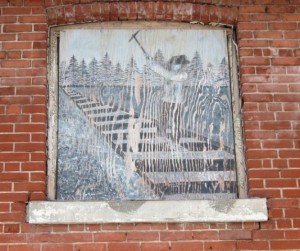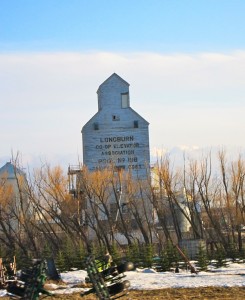Opening Lines: Riff No.2
by caroline on June 30, 2011
OPENING LINES: Riff No.2, June 2011
“To Pass Back Through The Heart”-PART II
“Recordar: to remember, from the Latin re-cordis,
to pass back through the heart.”
Eduardo Galeano, The Book of Embraces, 1991
(translated from the Spanish by Cedric Belfrage with Mark Schafer)
With the porter’s second call for breakfast, the professor pushed up the blind on our window. Outside the sky was grey; clouds hung low on the highest peaks. We were in the Canadian Rockies.
We dressed quickly, and with that towering landscape speeding by to the rhythm of clattering wheels, we lurched along corridors to the dining car, dipping only occasionally through the curtains of a startled passenger’s bedroom.
From car to car, danger signs warned passengers not to linger in the couplings between the cars.
At the door to the dining car, I lingered, and as I felt the couplings shifting under my feet, I remembered all about lingering. As a kid, my brothers and I lingered in the spaces between cars; we’d undo the metal accordion gates whenever we found them unlocked, stick our heads out open windows, gulp our breath in a sudden whoosh of soot laden air from the coal fired steam engine. Probably we’d push each other, compete for balancing rights on the wiggly articulated flooring. I have one memory, which the professor insists is fantasy, of gaps appearing in the floor, maybe as the train entered a curve, and there would be a fleeting glimpse of heavy steel wheels sparking against polished track, ties flashing past at our feet.
(But I will have my memory. Tomorrow, when the wonder of great mountains recedes, and the land drops off to a roll and then flattens, I will pass back through the heart of my childhood. Nothing stirs my heart like the sight of the prairie landscape. This is a mystery to me. And if fantasy finds its way into my memories, it is most welcome. It will all be true.)
At this point, I believe I was mentioning to my now ravenous professor that I’d be tripping out on nostalgia for the next few days, when he ushered me forcefully through the door to the dining car. Luckily his reply was lost in the buzz of animated chatter that greeted us. A frantic looking server, straddling the aisle with a tray of clinking juice glasses, caught my eye and deftly lowered the tray without a spilling a drop. Be a minute, she called out to us, her laughter trailing behind her as she disappeared into the kitchen with the empty tray. Minutes later, we were seated at our table nodding yes to every coffee pot passing by while we listened to a table mate’s entire life history and worked our way through sausages and scrambled eggs and a mountain of buttery toast. We were chugging (if diesels chugged) through a narrow mountain pass as Reema locked us all into her tale of gathering stones for her sister’s new garden fountain in Toronto. She’d be getting off at each stop, she announced to everyone within hearing distance, even in the middle of the night, she added dramatically, eyebrows raised, and she’d find the perfect stones for the fountain.
Over the next couple of days, we’d hurry past her on our way to the dome car, avoiding the tiresome recitation of every date and place on every chalky stone lined up on her bar car table.
But members of the crew saw something else in what Reema was doing. In her collection of annotated stones destined for a fountain in suburban Toronto, they recognized a record of the railway artery still pulsing through the heart of a country. The crew presented her with a rusty old spike found in one of the many piles of ripped up track along the line. The *spike* of course, is a symbol of a great Canadian vision that took shape on the backs of coolies from China and ‘navvies’ from Ireland. The spike that was presented to Reema though, was more a reminder of the now abandoned rail links that were once the crucial lifeline to small towns, to mining, logging, and farming communities with their networks of supporting economies. The crew loved Reema’s eccentric way of valuing those who still worked the rails, those who still leaned out of front porches and storefronts still facing on to the track, everyone alert for the sounds of the next approaching train as they went about their business.
 *The Last Spike*
*The Last Spike*
(an aside, skipping forward to our final day: the train pulled into Hornepayne, Ontario, a once thriving logging and mining community. Here we had a chance to get off and walk around town. Many of us photographed the boarded up windows of the abandoned railway station. Each one was a painted record of a moment in the history of the town, of the railway, of the region. Back in Ottawa, I discovered an online message board for past and present residents of Hornepayne. There was a lively discussion about town reunions, and about the fate of the old station, which was scheduled for demolition. There was a debate about demolishing it, some folks wanting it gone, others wanting to restore it, and preserve its painted windows. The station remains today, its painted windows fading, but still depicting Hornepayne’s ‘old coal chute’, the ‘lyric theatre’, the ‘first bridge over the Jackfish River’, a local church, the post office, the region’s forest fires, a proper tea time for a logger and his lady friend in her long skirt and stylish hat.)
When we crossed the border from Saskatchewan into Manitoba, we emerged from the rolling prairie oasis of the Qu’appelle valley, back into flat prairie land, still snow packed, its dark wet earth barely exposed along rivulets of run off that were winding into ditches, winding into the swell of a rising river flow.
I watched from my perch in the dome car as the line-side grain elevators appeared on the horizon, hoping to see one of the remaining wheat pool elevators. But as we drew nearer, what greeted us were hulking storage units constructed of concrete, branded with the logos of agribusiness. Imposters. These were not my prairie sentinels! Not the citadels still standing tall in my child’s memory. There was never meant to be a vanishing point for these beloved icons of a collective prairie prosperity.
Discouraged, I returned to my book, glancing up from time to time to enjoy the sky on this bright sunny day.
And then there it was, right in front of me.
Peeling paint, faded words, but clear enough.
Longburn Co-op Elevator Association, Pool No. 198.
There is no more Wheat Pool of course, and this signifies profound losses for the prairie grain farmer, not the least of which is the loss of the word Co-op. Here’s a quote from a recent article by Helen Forsey which provides an excellent back ground on the Canadian Wheat Board Act along with an explanation of its current situation. (for the full article please go to: rabble.ca/blogs/bloggers/making-it-count/2011/05/prairie-strong-no-longer-harper%E2%80%99s-renewed-attack-canadian-whe )
The Canadian Wheat Board is ‘the largest of our farm marketing boards, it is also one of the biggest, oldest and most stable collective bargaining units in the country. As such, it represents a ripe field of temptation for Stephen Harper and his corporate backers to swing their ideological scythes and try to make off with the harvest.”
In conclusion, here’s a video of a Saskatchewan grain elevator being brought down by the giant teeth of an eerily insect like mighty machine. Some phoenix will surely rise from these ashes; there is ingenuity and resilience in the people, and one still wants to hope for a non GMO future for the prairie grain farmer.
Definitely worth the four minute view!
I would love to hear your comments and reactions.
Thanks for tuning in to Opening Lines.


6 comments
I enjoyed lingering with your words…& the flight of the birds from the toppled grain elevator.
by Patricia Hurdle on 07/01/2011 at 3:52 am. #
Carol! Your words created such a vivid description of the scenery I could clearly see it all. It brought back all the memories of my trip across Canada. ..thank you…
by Maxine on 07/02/2011 at 12:39 pm. #
Thank you for taking me out to the prairies with you. I was jostling from seat to seat with you, hands at the ready to catch each seat back with every unexpected lurch. Great video!!
by Hollis Morgan on 07/07/2011 at 1:53 pm. #
This is lovely, a perfect glimpse for the prairie-deprived such as myself. Beautifully written!
by Binnie on 07/12/2011 at 8:05 pm. #
I thought this was wonderful — brought it all back so vividly and beautifully, I seem to feel the carriage again under my feet.
by Parker on 07/13/2011 at 8:29 pm. #
You are right. There were places in the floor between the cars where you could see the wheels and the track. On the sides. Other than that I agree with Parker.
by Merrill on 07/19/2011 at 3:45 am. #